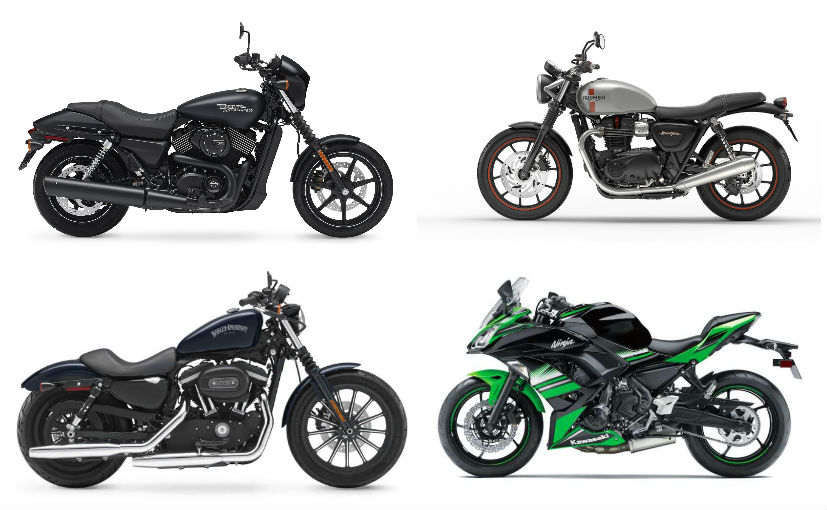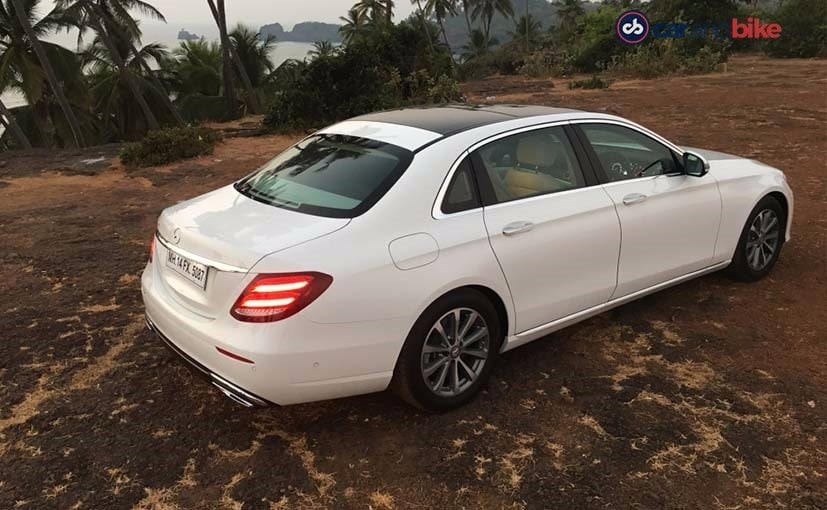GST: Small Cars To Cost More; Luxury Cars, Two-Wheelers Could Benefit

- Motorcycles with more than 350cc engine will attract a total of 31% tax
- Small diesel cars with engine of less than 1500 cc to be charged 3% cess
- Mid-sized cars, SUVs and luxury cars will attract 15% cess
Small cars less than four metres in length and with petrol engine of up to 1200 cc will attract 1 per cent cess on top of the peak rate. Small diesel cars with engine of less than 1500 cc will be charged 3 per cent cess. Mid-sized cars, SUVs and luxury cars will all attract 15 per cent cess.

Now, the Society of India Automobile Manufacturers or SIAM has already suggested a 2 slab approach to this issue - since many members have been worried about the taxation gap between smaller and larger cars shrinking. But it seems the government has consensus on a uniform rate.
While small cars will probably see a price hike, luxury car manufacturers might have something to smile about. It appears that thanks to this fixed slab of 28 per cent there could be a minor decline in prices of large luxury cars and SUVs. Currently, SUVs and cars which come with engines that are 1500cc or larger, the current taxation is between 41.5 to 44.5 per cent - 27-30 per cent central excise duty and the addition of state VAT. The implementation of GST on luxury cars will see a base 28 per cent tax and a 15 per cent cess which may see the total tax on such cars coming up to 43 per cent which is lower than what it currently is. So, we do expect a drop in price of such cars. Hybrid cars of more than 1500 cc engine would attract 15 per cent cess.
Motorcycles of more than 350 cc engine capacity will also attract an additional cess to the base 28 per cent tax. The cess for motorcycles with more than 350 cc engine has been kept at 3 per cent, taking the total incidence of taxation to 31 per cent. The two-wheeler sector currently faces as many as 13 different types of taxations taking the rate to 28 - 35 per cent.

Sarika Goel, Tax Partner, EY India, said "While the GST Council debated GST rates for vehicles, no consensus was reached on the same during today's meeting. While the taxation of luxury vehicles is widely being expected at 28% plus a cess of 15%, what is interesting to note is, that as per the media reports, the Council seems to be considering levy of a cess even on small cars in addition to GST at 28%, albeit at a much lower rate compared to luxury vehicles. Definition of what would classify as small cars and luxury cars respectively is also awaited - it appears likely that the same would be based on engine capacity, length etc rather than the retail price. The FM, during the press conference post today's meeting, mentioned industrial intermediates being taxed at 18 per cent GST; however, it is not yet clear whether auto components would fall under this category."

The industry is also waiting to know more about the tax levied on the auto component manufacturers. An executive from an automotive company said, "What needs to be seen is the taxation structure for the auto components manufacturers. If there is a sharp rise in the prices of components, we'll probably have to go back to the drawing board as far as pricing of the product is concerned."
We'll have to wait and watch now because the auto industry needs some amount of clarity on how the government chooses to define small and big cars. Will it stay with the current definition that creates a 4 metre divide or will it opt for price tags/engine displacements as the barometer is something the government needs to clear before the new regime can set in.
Trending News
 1 min readYamaha YZF-R2 Name Trademarked In India
1 min readYamaha YZF-R2 Name Trademarked In India
Latest News
 Jaiveer Mehra | Dec 21, 2025New Limited-Run Ducati Panigale V4 Marquez 2025 World Champion Replica RevealedSpecial edition Panigale V4 commemorates Marc Marquez's 2025 MotoGP Rider’s title.1 min read
Jaiveer Mehra | Dec 21, 2025New Limited-Run Ducati Panigale V4 Marquez 2025 World Champion Replica RevealedSpecial edition Panigale V4 commemorates Marc Marquez's 2025 MotoGP Rider’s title.1 min read car&bike Team | Dec 21, 2025KTM To Host First Adventure Rally In India In Feb 2026KTM also announced a third season of its KTM Cup for India, which commences in January 2026.1 min read
car&bike Team | Dec 21, 2025KTM To Host First Adventure Rally In India In Feb 2026KTM also announced a third season of its KTM Cup for India, which commences in January 2026.1 min read car&bike Team | Dec 20, 2025KTM 390 Adventure R To Be Launched In January 2026Bookings for the KTM 390 Adventure R are expected to open very soon, wit deliveries beginning in January 2026.2 mins read
car&bike Team | Dec 20, 2025KTM 390 Adventure R To Be Launched In January 2026Bookings for the KTM 390 Adventure R are expected to open very soon, wit deliveries beginning in January 2026.2 mins read car&bike Team | Dec 20, 2025BMW Motorrad India To Hike Prices By Up To 6 Per Cent From 2026The price hike will come into effect from January 1, 2026, and will be across the range of BMW two-wheelers and is due to the rupee’s sharp depreciation.1 min read
car&bike Team | Dec 20, 2025BMW Motorrad India To Hike Prices By Up To 6 Per Cent From 2026The price hike will come into effect from January 1, 2026, and will be across the range of BMW two-wheelers and is due to the rupee’s sharp depreciation.1 min read car&bike Team | Dec 19, 2025Next-gen Audi Q3 Spied In India Ahead Of Launch In 2026Third-gen Q3 made its global debut in mid-2025, getting notable tech upgrades and electrified powertrain options.2 mins read
car&bike Team | Dec 19, 2025Next-gen Audi Q3 Spied In India Ahead Of Launch In 2026Third-gen Q3 made its global debut in mid-2025, getting notable tech upgrades and electrified powertrain options.2 mins read car&bike Team | Dec 19, 2025Yamaha YZF-R2 Name Trademarked In IndiaThe Yamaha R15, one of Yamaha India’s most popular motorcycle models, is likely to continue, even when the R2 finally makes it debut.1 min read
car&bike Team | Dec 19, 2025Yamaha YZF-R2 Name Trademarked In IndiaThe Yamaha R15, one of Yamaha India’s most popular motorcycle models, is likely to continue, even when the R2 finally makes it debut.1 min read
 Bilal Firfiray | Dec 19, 2025Maruti Suzuki e-Vitara Review: Worth The Wait?After a long wait, the first-ever electric Maruti Suzuki is here. It’s the e-Vitara, and it comes with a few promises. But arriving this late, is it worth the wait? Or is it a case of too little, too late?9 mins read
Bilal Firfiray | Dec 19, 2025Maruti Suzuki e-Vitara Review: Worth The Wait?After a long wait, the first-ever electric Maruti Suzuki is here. It’s the e-Vitara, and it comes with a few promises. But arriving this late, is it worth the wait? Or is it a case of too little, too late?9 mins read Bilal Firfiray | Dec 18, 2025Mercedes-Benz G450d: The Subtle Power of EvolutionThe Mercedes-Benz G 450d evolves subtly with more power, improved efficiency, and modern tech, while staying true to the timeless G-Class design. And character.4 mins read
Bilal Firfiray | Dec 18, 2025Mercedes-Benz G450d: The Subtle Power of EvolutionThe Mercedes-Benz G 450d evolves subtly with more power, improved efficiency, and modern tech, while staying true to the timeless G-Class design. And character.4 mins read Janak Sorap | Dec 11, 2025Harley-Davidson X440 T First Ride Review: Smarter and SharperHarley-Davidson has taken the X440 and given it a more focused and engaging twist. The result is the X440 T—essentially the same platform but updated in areas that give the motorcycle more appeal and riders more thrill.5 mins read
Janak Sorap | Dec 11, 2025Harley-Davidson X440 T First Ride Review: Smarter and SharperHarley-Davidson has taken the X440 and given it a more focused and engaging twist. The result is the X440 T—essentially the same platform but updated in areas that give the motorcycle more appeal and riders more thrill.5 mins read Shams Raza Naqvi | Dec 10, 20252025 Mini Cooper Convertible Review: More Colour On Indian RoadsThe updated Mini Cooper Convertible is set to be launched in the Indian market in the next few days. We drive it around Jaisalmer for a quick review.5 mins read
Shams Raza Naqvi | Dec 10, 20252025 Mini Cooper Convertible Review: More Colour On Indian RoadsThe updated Mini Cooper Convertible is set to be launched in the Indian market in the next few days. We drive it around Jaisalmer for a quick review.5 mins read Preetam Bora | Dec 21, 20252025 Ducati Multistrada V4 S Review: Seriously Addictive!For 2025, the Ducati Multistrada V4 gets sharper, smarter and more sophisticated. We spent several days with the updated Multistrada V4 S to answer the big question – with a price tag north of Rs. 30 lakh, is it worth splurging?8 mins read
Preetam Bora | Dec 21, 20252025 Ducati Multistrada V4 S Review: Seriously Addictive!For 2025, the Ducati Multistrada V4 gets sharper, smarter and more sophisticated. We spent several days with the updated Multistrada V4 S to answer the big question – with a price tag north of Rs. 30 lakh, is it worth splurging?8 mins read































































































































